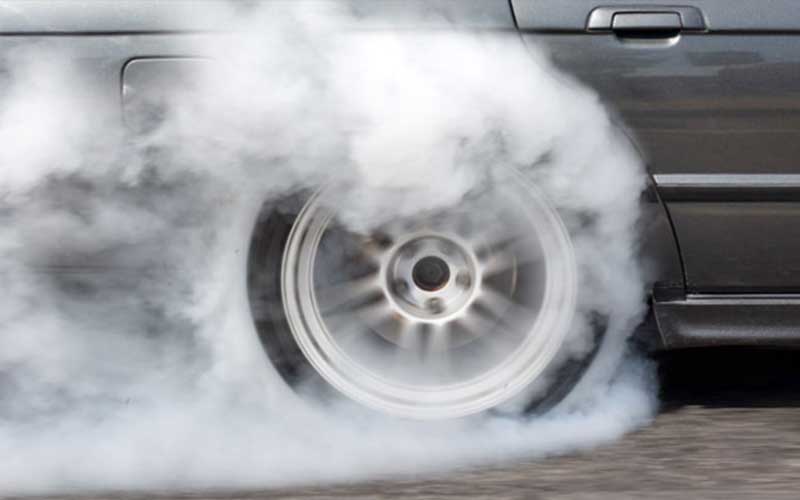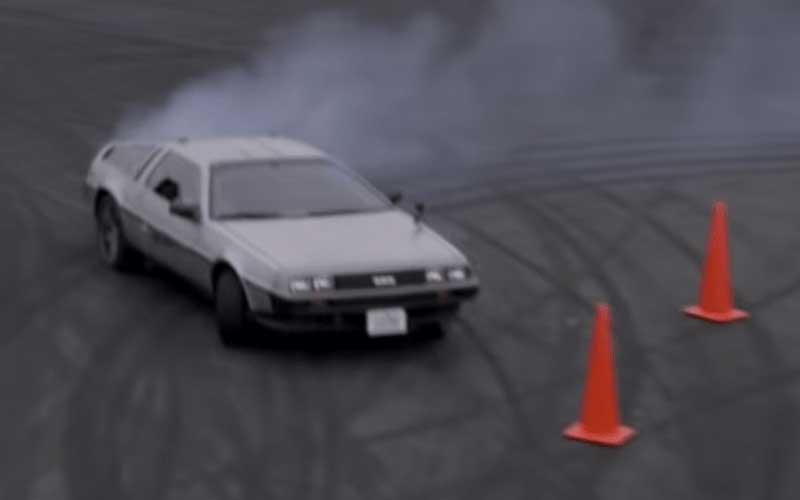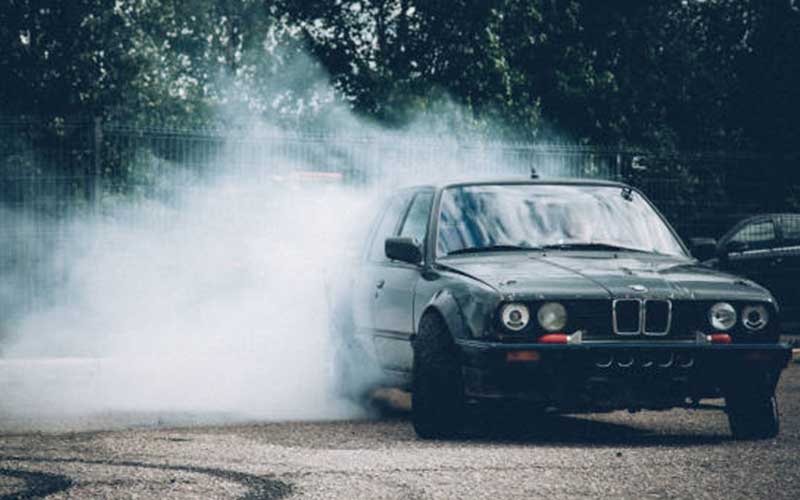Have you been asking yourself what drifting means? Can you drift in an automatic car? Do you want to know if it is harmful to drift in an automatic?
If yes, then this article is just for you. Stay put as we journey through this article.
The ability of an automatic gearbox to drift is a widely debated subject in the automotive industry. Some people believe it to be plausible, while others do not.
Although you can drift in an automatic, the experience is very different from drifting in a manual. When drifting, a back-wheel-drive vehicle is preferable to an automatic since it makes turning easier.
Let’s get started!
Can You Drift in an Automatic?
Yes. Any car can drift, in as much as its physical needs are met. The driver must put the car in a condition where the wheels can turn faster than the traction can keep up, therefore propelling the car sideways.
It’s a driving maneuver in which the driver purposefully oversteers, losing traction on all four or the back wheels while keeping control from turn entry to exit.
When the front wheels are pointed away from the turn, and the front slip angle is lesser than the rear slip angle, the vehicle drifts (for instance, an automobile turning left with its wheels pointed right). Drifting is intentional power sliding.
The driver must keep control of the steering and throttle while drifting.
The gas pedal must be moderate to keep the car moving without going too fast & losing control. For the vehicle to continue traveling in the intended direction, the drift must be initiated using the steering and maintained.
While drifting may be achieved in any vehicle, it is typically associated with Japanese automobiles and culture. Professional drifting tournaments are performed worldwide, and drifting has become a well-liked sport.
Drifting can be classified into three basic categories: power sliding, clutch kicking, and brake sliding. Power sliding occurs when the driver deliberately oversteers, loses traction in the back wheels and maintains control throughout the turn.
Brake sliding is when the driver applies the brakes to lose traction on the back wheels and initiate the drift. The rear wheels start to spin, and the drift is initiated when the driver rapidly releases the clutch before reinserting it.
Clutch kicking is the term for this technique.
Any car can be used for drifting; however, some vehicles are more suitable than others.
Because they frequently have back-wheel drive (It is necessary for drifting), superb weight distribution, and a low center of gravity, Japanese cars are sometimes regarded as the most significant vehicles for drifting. However, if driven appropriately, any car can drift.
Also Read: What Is Double Clutching? (Explained)
Do Automatic Cars Allow Drifting?

Drifting in an automatic vehicle is feasible but more challenging than drifting in a car with a manual gearbox.
An automobile’s automatic transmissions, however, vary from one another. For example, an automated vehicle does not have an automatic transmission; drifting requires a different technique.
In an automatic vehicle, you must maintain complete control of the automobile while in a particular gear ratio if you want to drift. The engine’s power dramatically affects how well you can steer your car while drifting.
It must match the compression ratio in terms of proportion. A too-high compression ratio could cause harm to the automatic transmission.
Is drifting in an automatic vehicle bad? It is a common question. The justification is that operating an automatic car recklessly is terrible. Drifting increases the risk of damage to your automatic vehicle.
Do Automatic Cars Make Drifting Harder?
Any task’s complexity in our world is relative, so its understanding is helpful. What you consider easy for you may be challenging for someone else. Similarly, something you think is rigid may be reasonably straightforward for many others to accomplish.
To the best of my experience and knowledge, drifting in an automatic transmission vehicle is more complex than in a manual gearbox vehicle.
However, several others overstate the challenge of drifting with an automatic vehicle. It is relatively easy to learn, but it will require more time than a car with a manual transmission.
How Do You Drift an Auto?
You can eventually try to float alone once you are satisfied that you have mastered the techniques mentioned above.
Using the Handbrake
Like always, pick a sizable region with little to no traffic. Once the automobile moves, accelerate while leaving room for the gear to rev. Drivers typically use the second(2nd) gear since it provides a wide range of speeds and is excellent for testing the engine’s torque. Turn the steering wheel to the inside of the turn while engaging the torque converter’s lock-up clutch. Pull the handbrake continuously while doing so.
Press the throttle, let go of the clutch, & then turn the steering wheel towards the direction of the slide. To keep a precise drifting angle, use the throttle as you apply more speed, the vehicle twists and drifts further from the turn’s center. The opposite result will occur if you use less throttle.
How to drift an automatic gearbox vehicle is shown here.
Drifting Emergency Brake
Several drivers claim that the best method to drive an automatic vehicle is to apply the emergency brake; however, doing so damages the transmission.
The car must be sped up, and the steering wheel must be turned in the drifting direction. The next step is to stop the vehicle by pulling the emergency brake.
How Does an Automatic RWD Vehicle Drift?
The method is similar to automatic automobile drifting. You must accelerate the vehicle at 20-30 mph to get the most torque while locking into a low gear ratio. To begin drifting, turn the wheel firmly in that direction and apply maximum throttle. To continue drifting after that, regulate the throttle.
Which Is Better for Drifting, a Manual or an Automatic?
But in a manual automobile, drifting is better and more pleasurable. It is easy and enjoyable. Drifting is primarily done in manual vehicles because of how easily the gear lever can be shifted, though it is possible to drift in an automated car with auxiliary equipment.
However, other elements, such as the characteristics of the automobile and the driver’s driving style, have a role in drifting in any vehicle. The driver should be capable of smoothly and accurately shifting gears.
Does Drifting Harm Your Car?
Your car’s transmission may be harmed by drifting. In addition, oversteering and other factors that accompany drifting might result in steering issues. Simply put, drifting can damage your car’s automotive transmission.
As you well know, drifting is entertaining to watch. If you wander, I’m sure it gives you thrills and is a pleasant experience. Although there are risks to your safety, it is enjoyable.
The gear and bearings in your car’s gearbox are under tremendous load when you drift. Therefore, you should drive carefully and deliberately to protect your car’s transmission.
Do several drifters still claim that the benefits of drifting are more than the drawbacks, but is this the case? A driving maneuver known as drifting involves using skill to negotiate corners, turns, bends, and curves.
You must drive extremely carefully and cautiously due to the significant acceleration involved. In addition, your car may sustain dents and scratches if you drift and lose control of the vehicle.
Advantages of Drifting
Listed below are just a few of the many benefits of vehicle drifting.
- It allows you to go around tight turns and curves with ease.
- All you require is to be inventive and skilled to drift; little space is required.
- Some racers noticed that their race vehicles’ batteries have a longer life when they regularly drift.
- Drifting makes it difficult for things to break easily.
Just some of the benefits of drifting are listed above.
Disadvantages of Drifting
There are drawbacks to drifting in addition to its positives.
- Some vehicles can’t drift. The type of car you drive & the wheels it has will determine how well it can drift.
- Not all terrains are suitable for drifting. To drift effectively, you need specific routes and surfaces.
- Additionally, your wheels may deteriorate more quickly than usual.
Can a Front-Wheel-Drive Vehicle Drift?
You can drift, put it, but only by applying the brakes. For drifting, a back-wheel-drive vehicle with an LSD(limited-slip diff.) is required. This is necessary since the tires must be able to spin at various speeds while still being able to grip the road.
Since the front wheels of a front-wheel-drive vehicle receive engine power, it is challenging to cause the rear wheels to lose traction & begin to slide.
A few have accomplished front-drive car drifting, but it requires much talent and training.
It’s also crucial to remember that even if you manage to drift your automobile, it will probably be damaged. Therefore, unless you are an expert drifter, we advise staying with back-wheel-drive vehicles.
A front-drive vehicle can drift in several ways; however, the most typical and fundamental approach is to utilize the brake. To do this, lock the back wheels with the handbrake while rotating the steering wheel into the corner.
As a result, the car’s rear will slide out, which you can control with the steering wheel and throttle. However, this strategy is more challenging since there is less weight over the back wheels of front-drive cars, as was previously explained. You must therefore take particular caution to avoid oversteering and spinning out.
We advise starting with a lower-powered vehicle, such as a simple Honda Civic, if you’re still set on drifting a front-drive car. This is because it will be simpler to operate &there’ll be less risk of damaging your vehicle.

What Changes Can I Make to My Car to Make It Better at Drifting?
A few changes can help your automobile perform better if drifting is something you take seriously.
The first step is to replace your tires with better-performing models. Then, you will have a more excellent grip and be able to drift for a long time without losing traction.
Consider updating your suspension as well. Doing this may maintain tire contact with the ground even when turning quickly.
Installing a limited-slip differential is the last option. Drifting requires both wheels to spin at different speeds; therefore, doing this will enable that.
These adjustments can be pricey, so we advise them if you’re committed to learning to drift.
Otherwise, concentrate on honing your skills and being familiar with your vehicle. You can quickly learn to drift like a pro with some practice.
Also Read: White Car With White Wheels
Frequently Asked Questions- Can You Drift in an Automatic?
Is it harder to drive an automatic?
For many reasons, drifting an automatic car is typically far more complex than drifting a manual one. With a manual transmission, you have more control over the vehicle, may choose your gears, and even drift with the aid of the clutch and handbrake.
Are drift cars manual or automatic?
The right gear for drifting depends on the course and the car you’re driving. It would help if you used manual transmission. Most corners can be taken in third gear, but some that are more tightly packed need to be taken in second or first. You’ll need to practice to get a feel for which equipment to use on each corner.
Can you do donuts in an automatic car?
It is made up of a pulley system rather than gears. It’s not difficult to perform a donut with an automated tranny. Make sure you have front-wheel drive first because achieving a doughnut with the rear wheels requires a different technique and is much more difficult. Turn off your traction control if you have one.
Does drifting hurt your vehicle?
I am aware that drifting puts one’s safety in jeopardy and damage tires. It additionally loads the suspension outside the turn and applies a lateral force to the base of the tire, rotating it about the axle. But robust and non-drifting turning also loads the suspension and applies torque to the wheel.
Can an automatic burn you out?
You require a vehicle with loads of horsepower to accomplish a burnout. Burnouts can be performed in an automatic or manual transmission car, though the former is usually easier. Since street tires have smoother surfaces emitting more smoke, they are also preferred for the best effect.
Can an AWD drift?
In an AWD car, both the front & rear tires are constantly spinning. To “break the tires loose,” the emergency brake must be applied when drifting in this manner. The vehicle slides when the tires are broken loose by the reduced coefficient of friction.
Can any automobile drift?
Any automobile can perform a drift; however, pros will either select local models that they are familiar with and comfortable driving or vehicles with a history of having good drifting characteristics (with 4-wheel drive or rear-wheel).
Conclusion- Can You Drift in an Automatic?
Many drivers find drifting a great experience because of the excitement and enjoyment it provides. Due to the gear lever’s existence, manual cars are optimal for enjoying it. Utilizing the throttle and the gear lever to their fullest potential is the key to drifting. The emergency brake or handbrake can be used to drift in an automatic vehicle, but for the optimum experience, a manual car is recommended.

